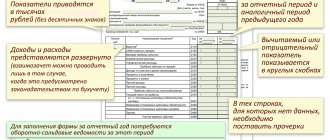Composition of the annual financial statements 2016
The annual financial statements of commercial companies must include:
- Balance sheet;
- Statement of changes in equity;
- Cash flow statement;
- explanatory notes to the balance sheet and reports;
- auditor's report - if the organization is subject to mandatory audit.
Statement of financial results (profit and loss statement);
The forms of the balance sheet and the above-mentioned reports were approved by Order of the Ministry of Finance of Russia dated July 2, 2010 No. 66n.
Attention! Insurance and credit organizations have their own reporting forms. For more information about them, see the relevant paragraphs of this reference material.
Accounting policy
Situation: is it necessary to submit a copy of the order approving the accounting policy for accounting purposes to the tax office?
No no need.
The legislation does not contain such requirements. In addition, the essential elements and principles of accounting policies are disclosed in the Explanations to the Balance Sheet and the Statement of Financial Results, which the organization submits to the tax office (clauses 17, 18 of PBU 1/2008, subclause 5 of clause 1 of Article 23 of the Tax Code of the Russian Federation) .
At the same time, the accounting policy for accounting purposes may contain information necessary when conducting audits (for example, the organization’s working chart of accounts, an approved list of primary documents used by the organization, etc.). Therefore, as part of an on-site inspection, the inspection has the right to require this document. The form of the demand is given in Appendix 5 to the order of the Federal Tax Service of Russia dated May 31, 2007 No. MM-3-06/338.
Within 10 working days after a written request is received from the inspection, the organization is obliged to submit a copy of the order approving the accounting policy. Such rules are established by paragraph 12 of Article 89 and paragraph 3 of Article 93 of the Tax Code of the Russian Federation.
If an organization does not comply with a request received, it may be fined. The fine will be:
- for organizations 200 rub. (clause 1 of article 126 of the Tax Code of the Russian Federation);
- for officials (for example, the head of an organization) from 300 to 500 rubles. (Part 1 of Article 15.6 of the Code of Administrative Offenses of the Russian Federation).
Deadlines for submitting annual reports
Article 23 of the Tax Code of the Russian Federation states that organizations are required to submit annual financial statements to the Federal Tax Service no later than March 31 of the year following the reporting year.
If March 31st falls on a Saturday or Sunday, then you can submit reports on the following Monday. In 2022, this day falls on a Friday, so there will be no postponement.
Since you can submit a report in different ways, the question arises of how exactly the date of submission of the report will be calculated:
- If the reporting is sent by mail in a valuable letter with a description of the attachment, this date is considered the day of its mailing. It is indicated on the postmark placed by the postal worker on the inventory of the attachment.
- If the reporting is submitted in person, this date is considered to be the date of its submission. The tax officer must indicate this date on a copy of the reporting or a copy thereof, which remains with the taxpayer. The date is put together with a signature from an employee of the Federal Tax Service, confirming that the tax authority has received a report from the organization.
- If the reporting is submitted electronically, the date of dispatch is considered to be the date indicated in the confirmation of dispatch, i.e. in an electronic document generated by a telecom operator or tax authority.
IMPORTANT! There is no need to submit interim accounting reports (for a quarter or a month) to the tax office.
Balance sheet: example of filling out the general form
An example of a balance sheet completed by specialists is of interest to many accountants, both beginners and experienced, especially if a complex situation arises.
Examples of balance sheets with entered indicators can be seen on the websites of almost all reference and legal systems. In addition, an example of a balance sheet can be a form filled out automatically by an accounting program. However, Form 1 - Balance Sheet for 2022 completed in this way requires its verification. To carry out such a check and correctly configure its completion in the program, you need to understand the entire mechanism for generating the balance sheet.
Let's look at how to draw up an accounting balance sheet using the example of accounting data for which the financial result is formed after carrying out the necessary regulatory operations and reforming the balance sheet.
Let's assume that we are talking about an organization engaged in manufacturing and wholesale trade. The features of her credentials are due to the fact that she:
- has OS and intangible assets;
- makes capital investments;
- has financial investments;
- creates reserves for depreciation of goods and materials and financial investments, reserves for doubtful debts;
- creates a reserve for vacation payments;
- takes loans from banks;
- reimburses VAT;
- receives reimbursement of expenses for sick leave from the Social Insurance Fund;
- applies PBU 18/02;
- has a profit for previous years;
- has a loss based on the results of work for the current year.
We will display its accounting data as of the reporting date in the form of a table with a breakdown by accounting accounts in relation to the current version of the chart of accounts, approved by order of the Ministry of Finance of the Russian Federation dated October 31, 2000 No. 94n.
The table will contain detailed data on debit and credit balances, which, for ease of presentation, are not broken down by subaccount and rounded to the nearest thousand rubles without decimal places.
| Account number | Debit balance | Credit balance | Note |
| 01 | 5 274 | — | Fixed assets |
| 02 | — | 1 017 | Depreciation of fixed assets |
| 04 | 305 | — | Intangible assets |
| 05 | — | 57 | Depreciation of intangible assets |
| 08 | 924 | — | Capital investments |
| 09 | 102 | — | Deferred tax assets |
| 10 | 1 014 | — | Material reserves |
| 14 | — | 101 | Provision for impairment of inventories |
| 19 | 219 | — | VAT on purchased assets |
| 20 | 1 714 | — | Unfinished production |
| 41 | 2 011 | — | Goods |
| 44 | 415 | — | Selling expenses |
| 51 | 543 | — | Cash in current accounts |
| 55 | 100 | — | Special accounts. 100 – long-term deposit |
| 58 | 314 | — | Financial investments. Of these, 107 are long-term, 207 are short-term |
| 59 | — | 62 | Provisions for impairment of financial investments. Of these, 20 are long-term, 42 are short-term |
| 60 | 907 | 10 103 | By credit - debt to suppliers, by debit - advances transferred to them |
| 62 | 9 125 | 642 | By debit - debt of customers, by credit - advances received from them |
| 63 | — | 1 115 | Provision for doubtful accounts receivable |
| 66 | 18 | 2 019 | Short-term loans with interest on them. For debit 18 – overpayment of interest |
| 67 | — | 3 004 | Long-term loans with interest on them. Of these, 2,342 are with a remaining maturity of more than 12 months, 505 are with a remaining maturity of less than 12 months, 157 are interest on all long-term loans |
| 68 | 516 | 1 327 | Calculations with the budget. By debit - overpayment of taxes and the amount of VAT to be reimbursed, by credit - debt to the budget |
| 69 | 54 | 219 | Calculations for insurance premiums. On debit – overpayment on them and the amount of compensation from the Social Insurance Fund, on credit – arrears in contributions |
| 70 | — | 1 095 | Payments to personnel regarding wages. Debt to employees |
| 71 | 98 | 355 | Calculations with accountable persons. By debit - amounts issued on account, by credit - debt to accountable persons according to advance reports |
| 73 | 150 | — | Settlements with personnel for other operations. 150 – short-term loan issued to an employee |
| 76 | 129 | 1 438 | Settlements with other debtors and creditors. On debit – interest on loans issued and VAT on advances received, on credit – debt on customer claims and deposited wages |
| 77 | — | 96 | Deferred tax liabilities |
| 80 | — | 100 | Authorized capital |
| 82 | — | 2 | Reserve capital |
| 84 | — | 239 | retained earnings |
| 96 | — | 972 | Reserves for future expenses. 972 – reserve for payment of vacations with a period of use of less than 12 months |
| 97 | 31 | — | Future expenses |
| Total: | 23 963 | 23 963 |
The balance sheet of an enterprise, filled out as an example of the 2021 sample, will look like this.
| Balance sheet sections | Amount at the reporting date | Formula for calculating the amount based on the accounting account numbers from which the balance values are taken |
| ASSETS | ||
| I. NON-CURRENT ASSETS | ||
| Intangible assets | 248 | 04 – 05 |
| Fixed assets | 5 181 | 01 – 02 + 08 |
| Financial investments | 187 | 55 + 58 (long-term) – 59 (long-term) |
| Deferred tax assets | 102 | 09 |
| Total for Section I | 5 718 | |
| II. CURRENT ASSETS | ||
| Reserves | 5 084 | 10 – 14 + 20 + 41 + 44 + 97 |
| Value added tax | 219 | 19 |
| Accounts receivable | 9 732 | 60 + 62 – 63 + 66 + 68 + 69 + 71 + 76 |
| Financial investments | 315 | 58 (short-term) – 59 (short-term) + 73 |
| Cash and cash equivalents | 543 | 51 |
| Total for Section II | 15 893 | |
| BALANCE | 21 611 | |
| PASSIVE | ||
| III. CAPITAL AND RESERVES | ||
| Authorized capital | 100 | 80 |
| Reserve capital | 2 | 82 |
| retained earnings | 239 | 84 |
| Total for Section III | 341 | |
| IV. LONG TERM DUTIES | ||
| Borrowed funds | 2 342 | 67 (loans with a remaining maturity of more than 12 months) |
| Deferred tax liabilities | 96 | 77 |
| Total for Section IV | 2 438 | |
| V. SHORT-TERM LIABILITIES | ||
| Borrowed funds | 2 681 | 66 + 67 (loans with remaining maturity less than 12 months) + 67 (interest on all long-term loans) |
| Accounts payable | 15 179 | 60 + 62 + 68 + 69 +70 + 71 + 76 |
| Estimated liabilities | 972 | 96 |
| Total for Section V | 18 832 | |
| BALANCE | 21 611 |
The correctness of filling out the balance sheet form 1 on the 20210 form can be checked arithmetically. This can be done in two ways: from the total of debit balances and from the total of credit balances.
When checking in the first way, from the total amount of debit balances on accounting accounts, it is necessary to subtract the values related to regulatory items (depreciation, provisions for impairment), i.e. credit balances on accounts 02, 05, 14, 59, 63. The result should be equal to the balance sheet asset total.
Let's check: 23,963 – 1,017 – 57 – 101 – 62 – 1,115 = 21,611.
A similar formula is used when checking in the second way: the values of regulatory items are subtracted from the total amount of credit balances on the accounting accounts (credit balances on the same accounts 02, 05, 14, 59, 63). The result should be equal to the total liabilities of the balance sheet.
Let's check: 23,963 – 1,017 – 57 – 101 – 62 – 1,115 = 21,611.
If the above accounting data related to interim reporting, then their only difference would be the presence of data on account 99 (due to the absence of balance sheet reformation performed only at the close of the year). In our example of the balance sheet before the reformation, account 99 had a loss of 70,000 rubles. (i.e., debit balance), and account 84 showed the profit of previous years in the amount of 309,000 rubles, which had not yet been reduced by the loss of the reporting year. In this case, the amount in the balance sheet would remain arithmetically the same, but the data on the line “Retained earnings” would be taken as the difference between the figures reflected in accounts 84 and 99. The total amounts of debit and credit balances in this case would be greater by the amount of the loss, and in the verification formulas the amount of loss would have to be additionally subtracted from them.
The balance sheet form 1 on the 2022 sample form, filled out automatically in the accounting program, must be checked. To do this, its figures are verified with data obtained from the consolidated balance sheet for the accounting accounts generated as of the reporting date. To select data on the analytics of property, financial investments, loans, additional capital, reserves, balance sheets for the corresponding accounting accounts are used. The greatest difficulty is checking the correctness of the formation of detailed balances on accounts for settlements with counterparties. Here you will have to sum up both the balances of individual accounts and the debt of specific counterparties.
The deadline for submitting financial statements, including the balance sheet, is set at March 31 of the year following the reporting year.
Find out what liability is established for late submission of financial statements and violation of accounting rules in the ConsultantPlus Tax Guide by receiving free trial access.
PBU and IFRS
PBU and IFRS are accounting standards. What is the difference?
PBU is an abbreviation for “Accounting Regulations”. These are Russian accounting standards that regulate the accounting of assets, liabilities or events of economic activity. PBUs are internal documents of Russia, they are adopted by the Ministry of Finance of the Russian Federation and are valid for commercial non-banking organizations (for banks and credit organizations, the provisions adopted by the Central Bank of the Russian Federation are used).
Today there are 24 PBUs in force, all of them are mandatory for use when preparing financial statements and maintaining accounting registers.
IFRS is an abbreviation for International Financial Reporting Standards. These standards are adopted by the International Accounting Standards Board (IASB), located in the UK.
IFRS is mandatory for use in some European countries, as well as for almost all European companies whose securities are traded on the stock exchange.
In Russia there is a program for reforming accounting in accordance with IFRS. By Order of the Ministry of Finance of Russia dated November 25, 2011 No. 160n, 63 documents were put into effect in our country: the IFRS standards themselves and explanations to them.
Forms of financial statements of commercial organizations
- Balance sheet (form 071001) - consists of 5 sections: Non-current assets, Current assets, Capital and reserves, Short-term and Long-term liabilities. The balance sheet form is filled out line by line, each line contains the indicators as of the reporting date of the reporting period, as of December 31 of the previous year and as of December 31 of the previous year.
- Statement of financial results (report and profit and loss) - form 0710002. It reflects information on the organization’s income and expenses, as well as its profits and losses for the reporting period and the same period of the previous year (this is established in PBU 4/99).
- Statement of changes in capital (form 0710003) - shows the movement of the organization’s capital for the reporting year and the two previous years.
- Cash flow statement (form 0710004) - shows the flow of cash and cash equivalents in the organization for the reporting year and the previous year.
- Explanatory note to the Balance Sheet and the Financial Results Report - these documents can be formatted either as a table or as text. In the case of a table, the organization itself determines the content of these explanations.
All these forms of financial statements, as well as the procedure for filling them out, were approved by Order of the Ministry of Finance of Russia dated July 2, 2010 No. 66n.
Small businesses also use the Balance Sheet and Financial Results Report forms approved by the same order of the Ministry of Finance.
Balance sheet: how to fill out item by item
To fill out balance sheet items, data on balances formed as of the reporting date is taken from specific accounting accounts. In relation to the current version of the accounting chart of accounts, approved by order of the Ministry of Finance of the Russian Federation dated October 31, 2000 No. 94n, when filling out the full form of the balance sheet 2022 - which can be downloaded for free in our article - the balances on the following accounts are used:
- for the article “Intangible assets” - the final balance on account 04 minus the total on account 05, while for account 04 the data included in the line “Results of research and development” is not taken into account, and for account 05 – figures related to intangible exploration assets ;
- for the article “Results of research and development”, data on R&D costs reflected in the balance on account 04 is selected;
- for the articles “Intangible exploration assets” and “Tangible exploration assets”, data on the costs of developing natural resources is taken from account 08 minus depreciation related to these assets, taken into account, respectively, on accounts 02 and 05;
- for the item “Fixed assets”, the data is determined as the difference between the balances of accounts 01 and 02 (account 02 does not take into account figures related to material exploration assets and profitable investments in tangible assets), to which is added the amount of capital investment costs recorded in the accounts 07 and 08 (except for the figures included in the lines “Intangible search assets” and “Tangible search assets”);
- for the article “Profitable investments in assets”, the difference between the balances of accounts 03 and 02 in relation to the same objects is taken;
- for the item “Financial investments” in non-current assets, data on long-term amounts (with a maturity of more than 12 months) in accounts 55 (for deposits), 58, 73 (for loans issued to employees) is selected, which are reduced by the amount of reserves for long-term investments (count 59);
- for the item “Deferred tax assets”, the balance of account 09 is taken;
- for the item “Inventories”, the amount is formed by adding the balances on accounts 10, 11 (both accounts minus the reserve recorded on account 14), 15, 16, 20, 21, 23, 28, 29, 41 (minus account 42, if accounting of goods is carried out with a markup), 43, 44, 45, 46, 97;
- for the article “Value added tax on acquired assets”, the balance of account 19 is taken;
- for the item “Receivables”, the debit balances on accounts 60, 62 (both accounts minus the reserves formed on account 63), 66, 67, 68, 69, 70, 71, 73 (minus the data recorded under the item “Financial attachments"), 75, 76;
- for the article “Financial investments (except for cash equivalents)” in current assets, data on short-term amounts (with a maturity of less than 12 months) in accounts 55 (for deposits), 58, 73 (for loans issued to employees) are selected, which are reduced for the amount of reserves for short-term investments (account 59);
- for the item “Cash and cash equivalents” the amount is obtained by adding the balances of accounts 50, 51, 52, 55 (except for deposits), 57;
- for the article “Authorized capital (share capital, authorized capital, contributions of partners)” the data is taken as the balance of account 80;
- for the item “Own shares purchased from shareholders”, the balance of account 81 is taken;
- for the article “Revaluation of non-current assets”, data on balances on account 83 related to fixed assets and intangible assets are selected.
- for the item “Additional capital (without revaluation)” the data is formed as balances on account 83 minus data related to fixed assets and intangible assets;
- for the item “Reserve capital”, the balance of account 82 is taken;
- for the article “Retained earnings (uncovered loss),” the annual balance sheet includes the balance of account 84, and when preparing interim reporting, two balances are added up: account 84 (financial result of previous years) and 99 (financial result of the current period of the reporting year), with In this case, the sum can be formed both by addition and by subtraction;
- for the item “Borrowed funds” in the section “Long-term liabilities”, long-term (with a remaining maturity of more than 12 months) debt on loans and borrowings is selected from the balances on account 67, while interest on long-term borrowed funds must be taken into account as part of short-term accounts payable;
- for the item “Deferred tax liabilities”, the balance of account 77 is taken;
- for the item “Estimated liabilities” in the section “Long-term liabilities”, from the balances on account 96, data on long-term reserves, the period of use of which exceeds 12 months, is selected;
- for the item “Borrowed funds” in the section “Short-term liabilities”, the balances on account 66, interest on long-term borrowed funds taken into account in the balances on account 67, and that debt on long-term loans and borrowings (account 67), which at the time of drawing up the report became short-term (less than 12 months left until its maturity);
- for the item “Accounts payable”, credit balances on accounts 60, 62, 68, 69, 70, 71, 73, 75, 76 are summed up;
- for the item “Deferred income”, the balances of accounts 86 and 98 are added up;
- for the item “Estimated Liabilities” in the “Short-Term Liabilities” section, from the balances on account 96, data on short-term reserves, the useful life of which is less than 12 months, is selected.
To fill out the combined items of the reduced balance sheet, the balances on the following accounts are used:
- for the article “Tangible non-current assets”, the sum of the balances on accounts 01 and 03 minus the balance on account 02 is determined, which is then added to the balances on accounts 07 and 08, which are classified as non-current assets;
- for the article “Intangible, financial and other non-current assets”, the difference in balances on accounts 04 and 05 is summed up with data on long-term amounts on accounts 55 (for deposits), 58, 73 (for loans issued to employees), reduced by the amount of reserves for long-term investments (account 59), with the balance of account 09 and with data on unfinished investments in intangible assets and R&D reflected in account 08;
- for the article “Financial and other current assets”, data on accounts 19, 55 (less long-term deposits), 58 (on short-term investments) is combined with a decrease in the amount of reserves related to them (account 59), 60, 62 (both accounts less reserves formed on account 63), 66, 67, 68, 69, 70, 71, 73 (less amounts of long-term loans), 75, 76;
- for the item “Capital and reserves” the total amount of balances on accounts 80, 81, 82, 83, 84 is determined;
- for the item “Other long-term liabilities”, the balances of accounts 77 and 96 are combined (in relation to reserves with a period of use of more than 12 months);
- for the item “Other short-term liabilities” the balances on accounts 86, 96 (in relation to short-term reserves) and 98 are summed up.
The items “Inventories”, “Cash and cash equivalents”, “Long-term borrowed funds”, “Short-term borrowed funds”, “Accounts payable” are filled out according to the same accounts as similar items in the full balance sheet.
About the features of filling out individual lines of the balance sheet
Accounting report and accounting in a simplified manner
Law 402-FZ on accounting allows some organizations (including small businesses) to maintain accounting records and submit reports in a simplified manner. At the same time, these organizations have the right to prepare financial statements in accordance with the generally established procedure. The corresponding decision is made by organizations independently.
According to a simplified scheme, they can keep records:
- Participants of the Skolkovo project.
- Small businesses.
- Non-profit organizations.
The law specifically stipulates who does not have the right to conduct simplified accounting and submit simplified reporting. This:
- organizations whose financial statements are subject to mandatory audit;
- Housing complexes, housing cooperatives and microfinance organizations;
- credit consumer cooperatives;
- state organizations;
- political parties;
- bar associations, law offices, chambers and consultations;
- notary chambers;
- non-profit organizations performing the functions of a foreign agent.
Accounting and reporting of small businesses
The criteria for classifying companies as small enterprises are specified in Article 4 of Federal Law No. 209-FZ dated July 24, 2007. The main ones: number of employees - no more than 250 people, annual income - no more than 2,000,000,000 rubles, participation share of other legal entities in the authorized capital (there are several options).
Small businesses only submit a Balance Sheet and a Statement of Financial Results. They are also given the right to add financial indicators to the report only for groups of items without detail.
As for the simplified methods of accounting, they are all listed in Information of the Ministry of Finance of Russia No. PZ-3/2015. This:
- Keeping records without double entry.
- Abbreviated chart of accounts.
- Simplified system of accounting registers.
- Possibility not to apply some PBUs.
- Cash method of accounting for income and expenses.
- Valuation of financial investments at their original cost (that is, without subsequent revaluation).
- And some other details.
Accounting and reporting of Skolkovo participants
Accounting and reporting for this category of companies are subject to the same rules that apply to small businesses.
Accounting report of non-profit organizations
Simplified methods of accounting for non-profit organizations are listed in Information of the Ministry of Finance of Russia No. PZ-1/2015 (this letter applies only to non-profit organizations!). They generally repeat the same rules that are established by Information of the Ministry of Finance No. PZ-3/2015 for small enterprises (see above in the text), with some minor changes.
The annual accounting report of a non-profit organization consists of a balance sheet, a report on the intended use of funds and appendices thereto.
The Report on the targeted use of funds discloses information about the receipt of funds by the NPO intended to support its statutory activities, and about the targeted use of these funds in accordance with the approved budget or financial plan. The report also contains data on the balance of these funds at the beginning and end of the reporting period (year).
The form in which NPOs prepare this report can be of two types:
- generally established form 0710006
- simplified form 0710006.
The second, simplified, can be used by those non-profit organizations that keep records according to a simplified scheme (they have the right to do this according to Law 402-FZ).
The first, general one, is used by all others. Or, if desired, “simplified” people can also use it.
Both forms were approved by Order of the Ministry of Finance of Russia dated July 2, 2010 No. 66n.
Accounting statements of budgetary organizations
The reporting of budgetary, autonomous and government institutions is regulated by separate regulations. It differs from the reporting of commercial companies. Moreover, this reporting is also different for different types of budgetary institutions, although it has similar principles and features.
Budgetary and autonomous institutions draw up and submit financial statements in accordance with the Instructions on the procedure for compiling and submitting annual and quarterly financial statements of state (municipal) budgetary and autonomous institutions, approved by Order of the Ministry of Finance of Russia dated March 25, 2011 No. 33n.
government institutions are guided by another document - the Instruction on the procedure for compiling and submitting annual, quarterly and monthly reports on the execution of budgets of the budget system of the Russian Federation, approved by Order of the Ministry of Finance of Russia dated December 28, 2010 No. 191n.
General reporting requirements for budgetary, autonomous and government institutions are as follows:
- Reporting is prepared based on the results of the calendar year.
- The data reflected in the statements must be confirmed by the results of the inventory of assets and liabilities.
- The report must be signed by the manager and chief accountant and can be submitted both on paper and electronically.
Reporting must be submitted in the following forms:
- Institutional balance sheet (form 0503730 - for budgetary and autonomous, form 0503130 - for government institutions)
- Certificate on consolidated settlements (form 0503710 - for budgetary and autonomous, form 0503125 - for government institutions)
- Certificate for the conclusion of budget accounting accounts (form 0503725 - for budgetary and autonomous, forms 0503110 and 0503111 - for government institutions)
- Report on the execution of the plan/budget (form 0503737 - for budgetary and autonomous, forms 0503127, 0503317 and 0503117 - for government institutions)
- Report on the obligations assumed by the institution (form 0503738 - for budgetary and autonomous, form 0503128 - for government institutions)
- Report on financial results of activities (form 0503721 - for budgetary and autonomous, form 0503121 - for government institutions)
- Explanatory note (form 0503760 - for budgetary and autonomous, form 0503160 - for government institutions)
- Certificate of amounts of consolidated revenues to be credited to the budget account (form 0503184 - only for government institutions)
- Balance of budget execution (form 0503120 - only for government agencies)
- Cash flow statement (form 0503123 - only for government institutions)
- Report on cash receipts and outflows of funds (form 0503124 - only for government institutions)
- Separation balance sheet (form 0503230 - only for government institutions)
- Consolidated statement of financial results (form 0503321 - only for government institutions)
- Consolidated cash flow statement (form 0503323 - only for government institutions)
Organization tax reporting forms
Tax reporting for commercial and non-profit organizations is similar. It depends on the taxation system, whether the company has taxable objects and on the performance of certain actions.
Let's consider standard reporting forms for taxes and contributions:
| Tax/Contribution | Report form | Where and when to submit |
| Income tax | The declaration was approved by order of the Federal Tax Service dated September 23, 2019 No. ММВ-7-3/475 | Based on the results of the reporting period, the Federal Tax Service |
| Agricultural tax | The declaration on Unified Agricultural Tax was approved by order of the Federal Tax Service dated July 28, 2014 No. ММВ-7-3/384 | Based on the results of the reporting year, the Federal Tax Service at the place of registration |
| Single tax according to the simplified tax system | The declaration under the simplified tax system was approved by order of the Federal Tax Service dated December 25, 2020 No. ED-7-3/958 | Based on the results of the reporting year, the Federal Tax Service at the place of registration |
| VAT | The VAT return was approved by order of the Federal Tax Service dated October 29, 2014 No. ММВ-7-3/558 | Every quarter at the Federal Tax Service at the place of registration, electronic form (for almost everyone) |
| Property tax | The declaration was approved by order of the Federal Tax Service dated August 14, 2019 No. SA-7-21/405 | At the end of the year, in the Federal Tax Service at the location of the property in the general case |
| Personal income tax | The calculation of 6-NDFL was approved by order of the Federal Tax Service dated October 15, 2020 No. ED-7-11/753 | Based on the results of the quarter, half year, 9 months and year to the tax office at the place of registration |
| Contributions to pension, health and social insurance | The RSV form was approved by order of the Federal Tax Service dated September 18, 2019 No. ММВ-7-11/470 | Based on the results of the quarter, half year, 9 months and year to the tax office at the place of registration |
| Contributions for injuries | Calculation 4-FSS approved by FSS order dated September 26, 2016 No. 381 | Based on the results of the quarter, half a year, 9 months and a year in the Social Insurance Fund at the place of registration |
Some organizations additionally submit declarations for gambling tax, water tax, mineral extraction tax, etc.
Accounting statements of banks and credit organizations
The accounting statements of banks and credit institutions are special. It is regulated by the regulatory documents of the Bank of Russia. The fundamental documents are the “Regulations on the rules of accounting in credit institutions located on the territory of the Russian Federation” (approved by the Bank of Russia on July 16, 2012 No. 385-P) and the Bank of Russia Directive dated September 4, 2013 No. 3054-U “On the procedure for drawing up credit organizations annual accounting (financial) statements.” Attention!
New reporting forms for banks were established by Bank of Russia Directive No. 4212-U dated November 24, 2016, which canceled the previously effective Bank of Russia Directive No. 2332-U dated November 12, 2009.
New reporting forms include:
- 0409120 “Data on the risk of information for calculating the amount of participation of foreign capital in the total authorized capital of credit institutions licensed to carry out banking operations”;
- 0409702 “Information on unexecuted transactions”, developed for the purpose of maintaining statistics and operational monitoring of systemic risks of the financial system associated with the non-execution of certain types of transactions in financial markets.
The requirements for the formation of indicators of reporting forms and the procedure for their submission to the Bank of Russia are also clarified.
Annual reporting of banks is compiled based on the results of the calendar year. It is subject to mandatory audit. The auditor's report is submitted along with the annual report to the Bank of Russia.
Audit of financial statements
In a number of cases, the law establishes that an organization is required to conduct an audit of its financial statements. The list of cases when this is mandatory is established by Federal Law No. 307-FZ of December 30, 2008 “On Auditing Activities”. In particular, an audit is required:
- for all JSC (joint stock company);
- for companies whose securities are admitted to organized trading;
- for credit institutions, funds, securities market participants, insurance and clearing companies;
- for gambling organizers and lottery operators;
- for SROs (self-regulatory organizations);
- for state companies and corporations;
- for a number of specific companies (Rostec, Rosatom, Deposit Insurance Agency, Roscosmos, etc.);
- and also if the volume of revenue from the sale of products (goods, works, services) of the organization for the previous reporting year exceeds 400 million rubles or the amount of balance sheet assets as of the end of the previous reporting year exceeds 60 million rubles;
The auditor's report is not included in the annual financial statements, but is attached to it. The organization is obliged to submit the audit report to the state statistics body and publish it along with its annual reports.
Inventory
Before preparing annual financial statements, the organization is required to conduct an inventory. This obligation applies to all companies, regardless of their tax regime or legal form. The purpose of inventory is to ensure the reliability of accounting data and financial statements. To do this, during the inventory, the presence, condition and assessment of the organization's assets and liabilities are checked and documented.
This inventory is planned. To carry it out, the manager must approve the inventory regulations. The timing of such an inventory is from January 1 to December 31 of the reporting year.
An annual inventory is carried out on all assets and liabilities of the company, the verification is complete.
There are other reasons for conducting an inventory, unscheduled. They are established by the Regulations on accounting and financial reporting, Federal Law 402-FZ and PBU 4/99). This:
- change of financially responsible persons;
- identification of facts of theft, abuse or damage to property;
- natural disasters, fire or other emergencies;
- liquidation or reorganization of an organization.
Inventory procedure
- Step 1. Creation of an inventory commission
- Step 2. Receiving the latest incoming and outgoing documents
- Step 3. Receiving a receipt from the financially responsible person
- Step 4. Preparation of inventory records (acts)
- Step 5. Verification and documentary evidence of the presence, condition and valuation of assets and liabilities
- Step 6. Summarizing the results identified by the inventory
- Step 7. Approval of inventory results
- Step 8. Reflection of inventory results in accounting
You can read more about these stages in the “Practical guide to annual financial statements 2016” of the Consultant Plus system.
We prepare an annual report with Consultant Plus
The developers of the legal reference system Consultant Plus traditionally publish an annual analytical material, “A Practical Guide to Annual Accounting Reports.” This material usually includes very detailed explanations about the formation of an accounting report for the year, with examples, comments, samples of filling out document forms, etc.
The unique tool contained in this material, the “Interconnection of indicators” section, will help you once again check your finished report for the correctness of the details.
Read more about the Practical Guide to the Annual Report from Consultant Plus.
Forms in which it is possible to create a balance sheet
To be presented as official reporting, the balance sheet has a specific form. For the internal needs of an organization, it can have many modifications depending on the purpose and the type of data for its compilation:
- data can be taken either on specific dates (balance sheet) or by turnover for a period (turnover balance);
- the source data can be either only accounting, or only inventory, or accounting that is confirmed by inventory results;
- data can be taken into account either with the inclusion of regulatory items (depreciation, reserves, markup) or without them;
- the balance sheet can be drawn up in relation to only one of the types of activities of the enterprise;
- the balance sheet can have either a full or an abbreviated (simplified) form;
- the balance sheet can be drawn up in the form of equality between assets and the sum of capital and liabilities, or it can take the form of equality between capital and the difference between assets and liabilities;
- the balance sheet can be made for one organization or include data for several enterprises (consolidated and consolidated balance sheets);
- in relation to the event, there may be opening, liquidation, separation, and unification balance sheets;
- the balance can be preliminary, forecast, interim, final.
And this is not a complete list of possible options for drawing up a balance sheet for an organization to solve its internal problems. However, the fundamental approaches to filling out this form remain the same regardless of the way the source data is reflected in it.
You can download a sample balance sheet in the new edition with comments on completion from K+ experts in the ConsultantPlus legal reference system. To do this, get a free trial demo access to K+:








